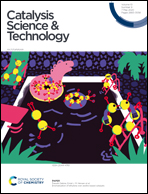Vacancy induced photocatalytic activity of La doped In(OH)3 for CO2 reduction with water vapor
Abstract
In this work, La doped plate-like In(OH)3 was synthesized by a simple one-step solvothermal method and used for photoreduction of CO2 with water as a reductant. A series of characterization techniques including SEM, TEM/HRTEM, XRD, Raman, XPS, PL, UV-vis DRS, TPD, and in situ FTIR were performed to determine the crystal structure, morphology, and optical and electronic properties, respectively. The results showed that the incorporation of doped La into the lattice of In(OH)3 resulted in the formation of more indium defects due to the lattice distortion, which narrowed the band gap and improved the visible light absorption capability. Meanwhile, the strength and amount of adsorbed CO2 species on the catalysts were greatly enhanced due to promoted surface basicity and increased defect sites originating from La doping. As a result, the La doped In(OH)3 samples show much higher photocatalytic activity for CO2 reduction compared to the undoped one. 1.5%La–In(OH)3 shows the highest photocatalytic activity among all the samples, with H2, CO, and CH4 formation rates of 54.33, 34.71, and 56.56 μmol gcat−1 h−1, respectively, which are about 3.6, 3.4, and 2.0 times higher than those on undoped In(OH)3, respectively. Comparatively, excessive La doping caused the formation of La(OH)3 while a limited amount of La enters the In(OH)3 lattice, which leads to decreased defect concentration and reduced photocatalytic activity. This work opens up a new perspective to efficiently regulate the vacancies of In(OH)3 with a facile approach and systematic investigation.



 Please wait while we load your content...
Please wait while we load your content...